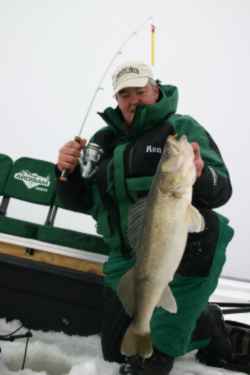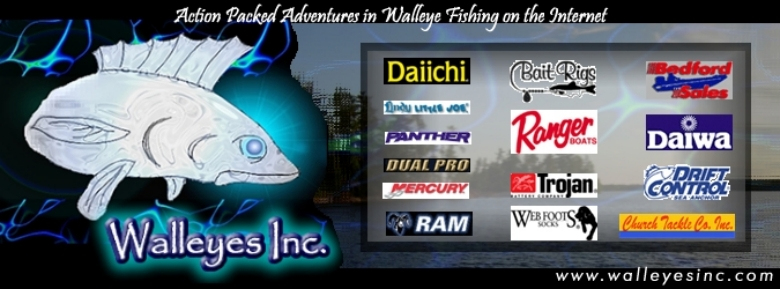|
The walleye action early in the ice fishing season can
run white hot at times, and what the fuss is all about. It’s
also why the most dedicated anglers do their level best to
try and get on the ice just as soon as they can. Fast action
and easy limits are what they’re hoping for, but it’s
not always fast and it’s not always easy. It could be
though, especially if you’re prepared.
Preparation includes trying to get a handle on location and
will depend on just how far along the season has progressed,
even if it’s just a matter of weeks. The thing is things
change, especially when it comes to early ‘eyes. Some
of the earliest spots to heat up are the shallowest and includes
rocks, gravel, sand and weeds.

Ron Anlauf had to adjust to nail this early ice walleye
|
You can certainly find fish in deeper water
but it’s not always an option and will depend on
how quickly safe ice develops. Shallow rocks, gravel,
and weed beds are where super charged walleyes stack up
and turn on but most of the action occurs during lowlight
periods early in the morning and late in the day even
in darker water. Dark water can definitely have an effect
and be more conducive to daytime activity but on darker
bodies of water the hottest action early in the season
usually occurs during the first couple of hours after
sunup and the last couple before sundown. On clearer lakes
you might be looking at the first and last hour of daylight
or less, and then on into the dark. The first hour or
so after the sun sets can be prime time for being on the
ice and well worth the effort it takes to stay out just
a little longer. Try that on a darker lake and you could
be just wasting your time. Many have tried but most have
failed when it comes to catching fish on the darkest lakes.
It seems that lowlight is great, but no light is a real
dream killer. Lakes that fall somewhere in between are
going to require some investigative angling to determine
if there’s any nighttime activity. |
A typical walleye movement starts with fish that have been
holding in deeper water moving up shallow as they become more
and more active and is something to consider when you’re
trying to put together a winning game plan. If you can get
to deeper water close to your shallow hot spot you might be
able to find active daytime fish. If not; you might have to
stick with the shallows and try to find the spot on the spot
and wait them out. Because the action can be short-lived there
really isn’t a lot of time for making big moves and
where you set up is basically what you’re going to be
stuck with. That can be good or bad depending on how many
hungry ‘eyes show up at just the right time. You can
help increase your chances by looking for a quick breaking
edge at the very top of a bar, or a little rock point or finger,
or an inside turn in a weedline, or where a little gravel
patch butts up or into the weeds. What you’re looking
for is something different than all the rest, something that
can help concentrate fish.
The early season hot spots can stack up with fish right away
but don’t expect the action to last forever. A couple
of good weeks might be all you get out of a good spot before
it’s time to move on. When the action slows down (or
comes to a complete stop) or fish no longer show up on a depth
finder; that’s a good indication it might be time to
find greener pastures. When it does happens it’s time
to look a little deeper, and deeper, and so on and so on,
depending on ice conditions. The deep to shallow feeding movement
rule of thumb still applies though, so look for deeper edges
to hold fish during the day and the top edges to load up early
and late in the day.
Tactics can also change with a changing season and it would
probably pay to adjust. Early on look for more aggressive
techniques like thumping jigging baits to pay off, and something
softer and more subdued to pick up the slack when things slow
down. Noisier baits like the Northland Buck-Shot Rattle spoon
are terrific early on and will keep on producing right through
the hard water season but you may to have tone it down a little
later on. You can start with a hard snap after snap to get
noticed, but slow it down if you’re not getting hit.
Jigging baits like the Mini Airplane Jig are another excellent
option, especially in clear water. Instead of a hard snap
up the technique requires more of a pull, allowing it to settle
out, and then following it up with another pull. Still baits
like a small jighead and minnow suspended below a float can
also produce and is a great one-two punch when set up in a
hole next to the one you’re jigging. Fish attracted
to the spoon will often hit the jig and minnow and will give
you the chance to double up if you draw in more than one taker.
A good flasher type depth finder like the Marcum LX-5 will
allow you to see exactly what’s going on while you’re
trying to figure it all out and whether or not the fish are
attracted or put off by your technique. If you’re seeing
fish and not getting hit it’s time to experiment, or
find another spot.
Adjusting to changing conditions is the moral of the story
which should help keep you on the fish. Instead of waiting
for a good report you can take control and put together your
own, but keep it to yourself if you want it to last. See you
on the ice.
|

